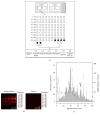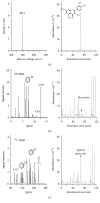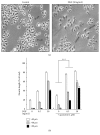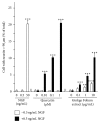Quercetin Potentiates the NGF-Induced Effects in Cultured PC 12 Cells: Identification by HerboChips Showing a Binding with NGF
- PMID: 29681968
- PMCID: PMC5850895
- DOI: 10.1155/2018/1502457
Quercetin Potentiates the NGF-Induced Effects in Cultured PC 12 Cells: Identification by HerboChips Showing a Binding with NGF
Abstract
Dementia is a persistent disorder of the mental processes and is strongly related to depression. However, the performance of current antidepression medicine is far from satisfactory. Herbal extract provides an excellent source to identify compounds for possible drug development against depression. Here, HerboChips were employed to search herbal compounds that could bind nerve growth factor (NGF). By screening over 500 types of herbal extracts, the water extract of Ginkgo Folium, the leaf of Ginkgo biloba, showed a strong binding to NGF. The herbal fractions showing NGF binding were further isolated and enriched. By using LC-MS/MS analysis, one of the NGF binding fractions was enriched, which was further identified as quercetin, a major flavonoid in Ginkgo Folium. Quercetin, similar to Ginkgo Folium extract, could enhance the effect of NGF in cultured PC 12 cells, including potentiation of neurite outgrowth and phosphorylation of Erk-1/2. This is the first report of discovering an NGF binding compound by using HerboChips from herbal extracts, which could be further developed for antidepression application.
Figures





Similar articles
-
Ginkgoghrelins, unique acylated flavonoid diglycosides in Folium Ginkgo, stimulate growth hormone secretion via activation of the ghrelin receptor.J Ethnopharmacol. 2016 Dec 4;193:237-247. doi: 10.1016/j.jep.2016.08.015. Epub 2016 Aug 12. J Ethnopharmacol. 2016. PMID: 27523747
-
Indication of nerve growth factor binding components from herbal extracts by HerboChip: a platform for drug screening on a chip.Chin Med. 2016 Jul 23;11:34. doi: 10.1186/s13020-016-0107-8. eCollection 2016. Chin Med. 2016. PMID: 27453720 Free PMC article.
-
VERIFICATION OF AUTHENTICITY OF GINKGO BILOBA L. LEAF EXTRACT AND ITS PRODUCTS PRESENT ON THE CROATIAN MARKET BY ANALYSIS OF QUANTITY AND RATIO OF GINKGO FLAVONE GLYCOSIDES (QUERCETIN, KAEMPFEROL AND ISORHAMNETIN) TO TERPENE TRILACTONES TO THE EFFECT OF UNMASKING COUNTERFEIT DRUGS ENDANGERING PATIENT HEALTH.Acta Clin Croat. 2019 Dec;58(4):672-692. doi: 10.20471/acc.2019.58.04.15. Acta Clin Croat. 2019. PMID: 32595253 Free PMC article.
-
EGb 761: ginkgo biloba extract, Ginkor.Drugs R D. 2003;4(3):188-93. doi: 10.2165/00126839-200304030-00009. Drugs R D. 2003. PMID: 12757407 Review.
-
Chemical analysis and quality control of Ginkgo biloba leaves, extracts, and phytopharmaceuticals.J Chromatogr A. 2009 Mar 13;1216(11):2002-32. doi: 10.1016/j.chroma.2009.01.013. Epub 2009 Jan 15. J Chromatogr A. 2009. PMID: 19195661 Review.
Cited by
-
A Herbal Mixture of Sesami Semen Nigrum and Longan Arillus Induces Neurite Outgrowth in Cultured Neurons and Shows Anti-Depression in Chronic Mild Stress-Induced Rats.Evid Based Complement Alternat Med. 2022 Jun 16;2022:8809546. doi: 10.1155/2022/8809546. eCollection 2022. Evid Based Complement Alternat Med. 2022. PMID: 35754681 Free PMC article.
-
Neuroprotective Effects of Glochidion zeylanicum Leaf Extract against H2O2/Glutamate-Induced Toxicity in Cultured Neuronal Cells and Aβ-Induced Toxicity in Caenorhabditis elegans.Biology (Basel). 2021 Aug 19;10(8):800. doi: 10.3390/biology10080800. Biology (Basel). 2021. PMID: 34440032 Free PMC article.
-
The neurotrophic activities of brain-derived neurotrophic factor are potentiated by binding with apigenin, a common flavone in vegetables, in stimulating the receptor signaling.CNS Neurosci Ther. 2023 Oct;29(10):2787-2799. doi: 10.1111/cns.14230. Epub 2023 Apr 26. CNS Neurosci Ther. 2023. PMID: 37101380 Free PMC article.
-
Loading and Release of Quercetin from Contact-Drawn Polyvinyl Alcohol Fiber Scaffolds.ACS Pharmacol Transl Sci. 2022 Nov 29;5(12):1305-1317. doi: 10.1021/acsptsci.2c00191. eCollection 2022 Dec 9. ACS Pharmacol Transl Sci. 2022. PMID: 36524014 Free PMC article.
-
Antidepressant Potential of Quercetin and its Glycoside Derivatives: A Comprehensive Review and Update.Front Pharmacol. 2022 Apr 8;13:865376. doi: 10.3389/fphar.2022.865376. eCollection 2022. Front Pharmacol. 2022. PMID: 35462940 Free PMC article. Review.
References
-
- The Henry J. Kaiser Family Foundation. Life Expectancy at Birth (in years), by Race/Ethnicity. Available at http://www.kff.org/other/state-indicator/life-expectancy-by-re/. Accessed on July 6, 2017.
-
- Alzheimer’s Association. What Is Dementia? Available at http://www.alz.org/what-is-dementia.asp. Accessed on July 6, 2017.
-
- Swedish Council on Health Technology Assessment. Depression treatment for the elderly. Available at http://www.sbu.se/. Accessed on July 6, 2017. - PubMed
LinkOut - more resources
Full Text Sources
Other Literature Sources
Miscellaneous

